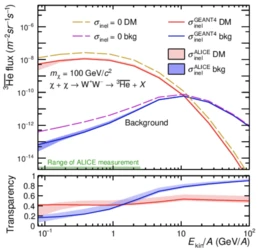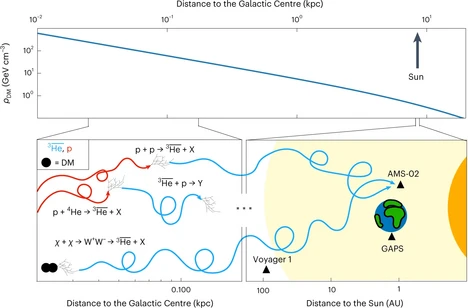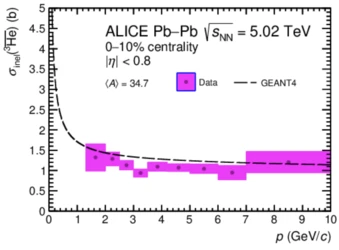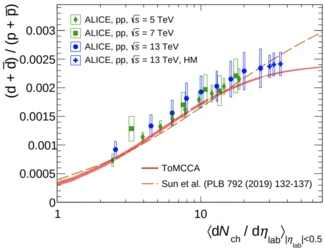Antinuclei at the LHC and in space
Antinuclei production

Antinuclei are composite objects, that is, they are made up of smaller particles (antiprotons and antineutrons) held together by the strong force, just like ordinary nuclei. However, they are made from antimatter, the evil twin of our regular matter all around us. These bound states of antiprotons and antineutrons cannot be found in nature, but have to be produced in high-energy collisions. The ALICE experiment located at the LHC is the ideal laboratory to study this mirror world. So far, it has been able to identify antideuterons (a bound state of an antiproton and an antineutron), antihelium-3 (two antiprotons and one antineutron), antitriton (one antiproton and two antineutrons), and even antihelium-4 (two antiprotons and two antineutrons) with momenta between 300 MeV/c and 10 GeV/c.
A large part of the interest in the study of these antinuclei stems from the pursuit of understanding Dark Matter (DM). DM makes up 80% of the mass of the Galaxy, yet we have little to no information about its nature. While many experiments are dedicated to directly detecting DM particles colliding with a detector, one can also study DM indirectly. Indeed, in many theories of DM, the particles can annihilate with each other, releasing enormous amounts of energy in the form of Standard Model particles, amongst these also antinuclei. Since there is (almost) no natural source of antinuclei in nature, the detection of antinuclei in space, particularly as part of cosmic rays, is lauded as a surefire signal of DM.
Models predict that 99% of all antideuterons and 99.999% of antihelions in space stem from Dark Matter, with a tiny fraction stemming from high-energy cosmic ray collisions with the interstellar medium (ISM, the thin gas made up of hydrogen and helium between stars), not unlike collider experiments on Earth. However, the models used for these predictions are still plagued with large unknowns; they are often anchored to unreliable data and use imprecise techniques to obtain the number of antinuclei arriving at Earth, which we call cosmic ray flux.
Our group develops ToMCCA, a state-of-the-art nuclei formation model based on the ‘coalescence’ idea: when particles like antiprotons and antineutrons are produced close together in a high-energy collision, they can ‘stick’ to form an antinucleus. This stickiness arises from the strong nuclear force, the fundamental interaction that holds protons and neutrons together. ToMCCA is able to reproduce all existing nuclei and antinuclei yield measurements performed at the LHC, with an unprecedented precision. Such a model is required in order to predict cosmic ray antinuclei fluxes with high precision. However, we are not there yet. The limitations of data at low collision energies, which are the most important ones for cosmic ray studies, are sparse. The upcoming SPS beam time will deliver an unprecedented amount of data to NA61, which will be able to perform the first high-precision measurements of antideuteron production at such low energy. With this data, we will be able to tune the ToMCCA model in the future for lower energies and make high-precision predictions for cosmic antinuclei.
Further reading:
Antinuclei absorption

A second critical aspect is the propagation of cosmic antinuclei, whether produced by dark matter decays or interactions of cosmic rays within the interstellar medium (ISM), from their point of origin to their eventual detection near Earth. Absorption can occur if inelastic collisions happen between the antinuclei and nuclei in the ISM, leading to the disappearance of these particles. The figure below illustrates the various processes that contribute to the antinuclei yield observed by experiments such as AMS-02 on the International Space Station.
What steps can we take to better understand this? Since antinuclei produced inside the ALICE detector travel through known detector material in a manner similar to how they would in space, we can use this environment to study absorption effects. Our approach involves leveraging the induced production and propagation within the detector material to accurately estimate, for the first time, the inelastic cross-section of low-energy antinucleons.

This methodology has been initially applied to antideuterons, and subsequently to antihelium-3 and antitriton nuclei, measured in both proton-proton (pp) and lead-lead (Pb-Pb) collisions at the LHC with center-of-mass energies of 13 TeV and 5.6 TeV, respectively. For the first time, the absorption cross-section for these nuclei has been measured as a function of their momentum. An example of the resulting absorption cross-section is shown hereafter. This observable is crucial for evaluating the transparency of our Galaxy to antinuclei as they travel through space.
Ultimately, this work allows us to estimate the flux of antinuclei -such as antihelium-3- originating from dark matter and cosmic ray interactions, both including and excluding absorption effects. Comparing these estimates has revealed, for the first time, that our Galaxy is highly transparent to antihelium-3, with approximately 50% of produced antinuclei, averaged over their production locations, reaching the detection point.
This is encouraging news for experiments like AMS, which has yet to detect antinuclei in space but is very likely to do so in the coming years.
Further reading:
